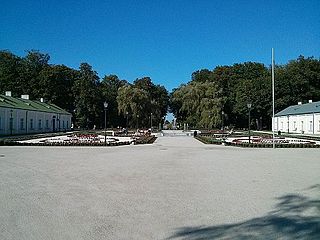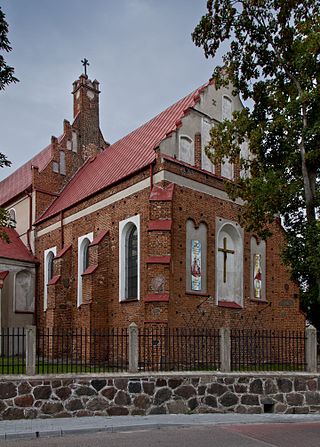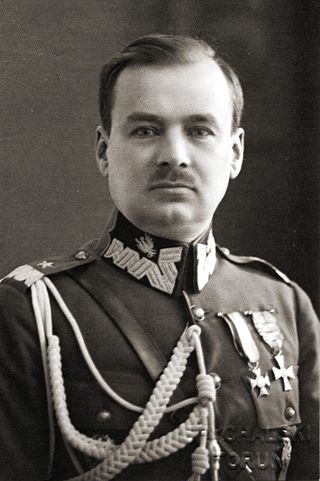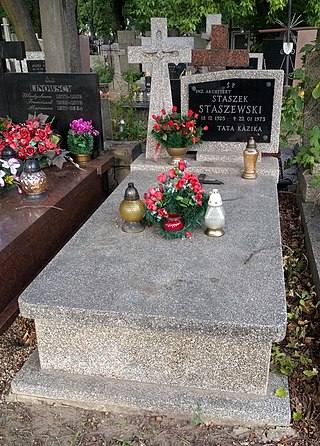Related Research Articles

Empire of the Sun is a 1987 American epic coming-of-age war film directed by Steven Spielberg and written by Tom Stoppard, based on J. G. Ballard's semi-autobiographical 1984 novel of the same name. The film tells the story of Jamie "Jim" Graham, a young boy who goes from living with his wealthy British family in Shanghai to becoming a prisoner of war in an internment camp operated by the Japanese during World War II.

Band of Brothers is a 2001 American war drama miniseries based on historian Stephen E. Ambrose's 1992 non-fiction book of the same name. It was created by Steven Spielberg and Tom Hanks, who also served as executive producers, and who had collaborated on the 1998 World War II film Saving Private Ryan. Episodes first aired on HBO starting on September 9, 2001. Critically acclaimed, the series won the Emmy and Golden Globe awards for best miniseries.

Końskie is a town in south-central Poland with 20,328 inhabitants (2008), situated in the Świętokrzyskie Voivodeship. Historically, Końskie belongs to the province of Lesser Poland, and since its foundation, until 1795, it was part of Lesser Poland's Sandomierz Voivodeship.
The NKVD prisoner massacres were a series of mass executions of political prisoners carried out by the NKVD, the People's Commissariat for Internal Affairs of the Soviet Union, across Eastern Europe, primarily in Poland, Ukraine, the Baltic states and Bessarabia. After the start of the German invasion of the Soviet Union on June 22, 1941, NKVD troops were supposed to evacuate political prisoners to the interior of the Soviet Union, but the hasty retreat of the Red Army, a lack of transportation and other supplies, and general disregard for legal procedures often led to prisoners being simply executed.
Kowalski is the second most common surname in Poland. Kowalski surname is derived from the word kowal, meaning "[black]smith".

Stalag XX-A was a German World War II prisoner-of-war camp located in Toruń in German-occupied Poland. It was not a single camp and contained as many as 20,000 men at its peak. The main camp was located in seven forts of the 19th-century Toruń Fortress, located in the southern part of the city.

Bergen-Belsen displaced persons camp was a displaced persons (DP) camp for refugees after World War II, in Lower Saxony in northwestern Germany, southwest of the town of Bergen near Celle. It was in operation from the summer of 1945 until September 1950. For a time, Belsen DP camp was the largest Jewish DP camp in Germany and the only one in the British occupation zone with an exclusively Jewish population. The camp was under British authority and overseen by the United Nations Relief and Rehabilitation Administration (UNRRA) with camp directors that included Simon Bloomberg. Today, the camp is a Bundeswehr barracks, having been a British Army base until 2015.

Maków Mazowiecki is a town in Poland, in the Masovian Voivodship. It is the powiat capital of Maków County. Its population is 10,850.

Wincenty Kowalski (1892–1984) was a Polish military commander and a general of the Polish Army. A veteran of both World War I and World War II, he fought in all the inter-war conflicts of Poland. During the Invasion of Poland of 1939 he commanded the Polish 1st Legions Infantry Division.

Wiktor Thommée (1881–1962) was a Polish military commander and a brigadier general of the Polish Army. A veteran of the Great War and the Russian Civil War, he is best known for his command over Piotrków Operational Group and the battle of the Bzura during the Invasion of Poland of 1939.

Stanisław Staszewski was a Polish architect and poet. He was the father of Kazimierz Staszewski and the author of many songs and ballads, sung both by his son and by Jacek Kaczmarski.

The "cursed soldiers" or "indomitable soldiers" were a heterogeneous array of anti-Soviet-imperialist and anti-communist Polish resistance movements formed in the later stages of World War II and in its aftermath by members of the Polish Underground State. The above terms, introduced in the early 1990s, reflect the stance of many of the diehard soldiers.

From Nazi Germany's invasion of Poland in 1939, the Wehrmacht recruited from Poland's 2.2% ethnic-German minority but did not enlist ethnic Poles on racist grounds. When Germany began losing the war in 1943, the Wehrmacht forcibly conscripted ethnic Poles, who were commanded with racist policies against them.

Katyń is a 2007 Polish historical drama film about the 1940 Katyn massacre, directed by Academy Honorary Award winner Andrzej Wajda. It is based on the book Post Mortem: The Story of Katyn by Andrzej Mularczyk. It was nominated for Best Foreign Language Film for the 80th Academy Awards.

Adam Remigiusz Grocholski war names "Brochwicz", "Doktor", "Inżynier", "Miś", "Waligóra", and pseudonym Żukowski was a Lieutenant Colonel (Podpułkownik) of the Polish Army. He retired from active service in 1934.
The term Robinson Crusoes of Warsaw refers to Poles who, after the end of the 1944 Warsaw Uprising and the subsequent planned destruction of Warsaw by Nazi Germany, decided to stay and hide in the ruins of the German-occupied city. The period of hiding spanned as long as three and a half months, from the day of the capitulation of the uprising, October 2, 1944, until the entry of the Red Army on January 17, 1945. The hideaways lived in the ruins of houses, basements, and bunkers which had been prepared ahead of time. They lived in extremely dire circumstances, while the city was being destroyed around them. Some managed to escape Warsaw, many were captured and killed by the Germans, while others survived until the withdrawal of German troops.

Gustaw Paszkiewicz was a soldier of the Imperial Russian Army, and officer of the Polish Army. He entered the military service in 1914, at the age of 22, fighting as Russian soldier in World War I. Paszkiewicz was a soldier until 1952.

Anna Maria Hinel was a Polish girl scout, activist of the underground independence movement during World War II, author of a diary from the German Nazi occupation.

The NKVD prisoner massacre in Berezhany was a Soviet war crime conducted by the NKVD in the city of Berezhany, then in occupied Poland and now in Ukraine. Between 26 and 30 June 1941, following the German invasion of the USSR, the Soviets executed at least 174 prisoners held in the Berezhany prison. This atrocity was one of several prisoner massacres carried out by the Soviet secret police and army during the summer of 1941.
References
- 1 2 3 "Wojenna narzeczona". filmpolski.pl (in Polish).
- 1 2 3 "Bride of War". imdb.com (in Polish).
- 1 2 Eryl Crump (8 March 2015). "Welsh Guardsman's tale of wartime love". dailypost.co.uk.
- ↑ "Tragic twist to wartime romance". tampabay.com. 5 December 1997.